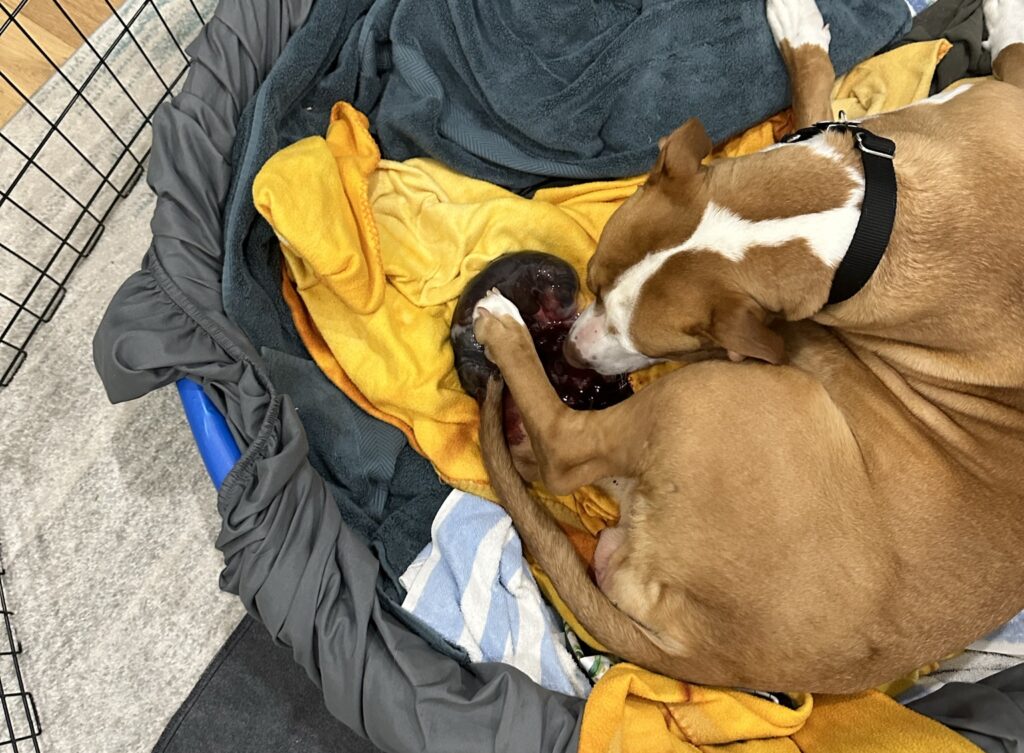In dogs, there are three distinct stages of labor that begin with minute contractions (not visible to our eyes) to visible contractions that produce a puppy to the delivery of a placenta. In dogs, the second and third stage of labor can be together, and then your whelping dog will go back into the second stage as she prepares to deliver the next puppy.
Stage 1 Labor in Dogs
The first stage of labor can often go undetected by hovering humans as it involves the initial contractions and dilation of the cervix. It is, effectively, the preparation for active labor and delivery for your dog. Instead, the more visible signs will be changes in your pregnant dog’s behavior.
Signs of Labor in Dogs
Your pregnant dog may exhibit one or more of the following behaviors leading up to her beginning stage 1 of labor and starting to move into stage 2 of labor. From my experience, refusing to eat, panting, restlessness and watery discharge are the clearest signs of a pregnant mama getting close to stage 2. Some pregnant dogs will nest a week or more before they’re due, and some dogs will have almost no lactation right before they start the labor process!
- Restlessness
- Nesting
- Refusing to eat
- Panting
- Trembling
- Vomiting
- Increased urination
- Clear, watery discharge
- Lactation
For those able to, you can take a rectal temperature of your pregnant dog as she gets closer to labor. If her temperature drops below 100 degrees, she will typically start the first stage of labor within 24 hours.1
Stage 1 of labor can last as long as 24 hours, though it is more typical to last between 6 and 12 hours before progressing into stage 2.2
Stage 2 Labor in Dogs
Stage 2 of labor in dogs is when you may be able to see visible contractions in your pregnant dog. Sometimes, you can see the contraction ripple across her body, but other times, it will simply look like she is tensing up.3 You may notice her tail rises and falls or tenses. She may stop panting, grit her teeth or even grunt. These are all signs of active contractions where you can expect a puppy soon. Below is a video of one of my pregnant mamas with an intense contraction before the first puppy was delivered.
You can look at her vaginal area to check for dilation and preparation for puppy delivery or to see if a puppy is incoming, which can alert you if she is having trouble pushing out a puppy as well. If a puppy is imminent, you will see a grayish water balloon-like object pushing out of her vulva.
How long is dog labor?
It can take up to two hours between the start of contractions and delivery of the first puppy, but she should not be heavily straining for more than 30 minutes. If she has been straining for more than 30 minutes without delivering a puppy or she has had contractions for four hours without delivering a puppy, you should contact your veterinarian and/or prepare to go to the emergency room.
You may see green discharge prior to the first puppy, as green discharge occurs as each amniotic sac separates from each placenta, but you may need to reach out to a veterinarian if it has been more than 30 minutes since seeing green discharge and no puppy has been delivered. You will see a mix of clear, green and red discharge; it will look like Christmas gone horribly wrong 🫣
A smooth, more typical delivery will see puppies delivered every 30 to 60 minutes, but it can take up to 24 hours to deliver all puppies.4 It is not uncommon to have two puppies delivered during a 5 to 15 minutes as dogs have two uterine horns; it can even be puppy, puppy, placenta and placenta in a short period of time.5 Puppies can be delivered head-first or tail-first; both are totally normal.6
What happens during labor for dogs?
Once a puppy is pushed out, they are delivered in an amniotic sac, which your mama dog should instinctually tear open, allowing the puppy to breathe. If she does not do this in a minute or two, you can tear open the sac yourself and rub the pup dry using a towel.7 I have had instances where my mama dog will go after the placenta before tearing open the sac, and I will tear open the sac to ensure the puppy gets oxygen. I also thoroughly dry off each newborn puppy as mom gets distracted or focuses on delivering the next puppy.
If you have pulled the puppy away from mom to open its sac or dry it off, you will want to bring the pup back to mama to have her tear off the umbilical cord. If your mama does not tear the umbilical cord or is doing it too closely, you may want to intervene and knot the umbilical cord about one inch away from the pup’s belly, then use sterilized scissors to cut just after the knot.8

Stage 3 Labor in Dogs
Stage 3 is the expulsion of the placenta. For every puppy delivered, there should be a placenta also delivered. In dogs, stage 2 and stage 3 can often happen simultaneously: you will have the puppy in its amniotic sac and its detached placenta delivered together or one after the other. It is not uncommon for mom to eat the placenta, but it can give her an upset stomach later on. I’ve never been able to successfully stop a mama from eating one, though you may certainly give it a try!
Footnotes
- Weir, Malcolm Weir. “Breeding for Pet Owners – Whelping in Dogs.” VCA Hospitals, vcahospitals.com/know-your-pet/breeding-for-pet-owners-whelping-in-dogs. ↩︎
- Paul Pion, D. V. M., and Gina Spadafori. “Veterinary Partner.” VIN.com, 8 Aug. 2017, veterinarypartner.vin.com/default.aspx?pid=19239&id=4951546. ↩︎
- Davidson, Autumn P. “Labor and Delivery in Dogs and Cats.” Merck Veterinary Manual, Merck Veterinary Manual, 31 Aug. 2020, www.merckvetmanual.com/management-and-nutrition/management-of-reproduction-dogs-and-cats/labor-and-delivery-in-dogs-and-cats. Accessed 28 Aug. 2024. ↩︎
- Davidson, Autumn P. “Labor and Delivery in Dogs and Cats.” Merck Veterinary Manual, Merck Veterinary Manual, 31 Aug. 2020, www.merckvetmanual.com/management-and-nutrition/management-of-reproduction-dogs-and-cats/labor-and-delivery-in-dogs-and-cats. Accessed 28 Aug. 2024. ↩︎
- O’Connor, Cindy. Whelping and Dystocia. 23 Apr. 2015, www.akcchf.org/educational-resources/podcasts/podcast-transcripts/Whelping-and-Dystocia-Dr-Cindy-O-Connor.pdf. ↩︎
- Dockweiler, Jenna. “The Normal Whelping Process | Cornell University College of Veterinary Medicine.” Www.vet.cornell.edu, www.vet.cornell.edu/departments-centers-and-institutes/riney-canine-health-center/canine-health-information/normal-whelping-process. ↩︎
- Paul Pion, D. V. M., and Gina Spadafori. “Veterinary Partner.” VIN.com, Aug. 2017, veterinarypartner.vin.com/default.aspx?pid=19239&id=4951546. ↩︎
- Paul Pion, D. V. M., and Gina Spadafori. “Veterinary Partner.” VIN.com, Aug. 2017, veterinarypartner.vin.com/default.aspx?pid=19239&id=4951546. ↩︎






